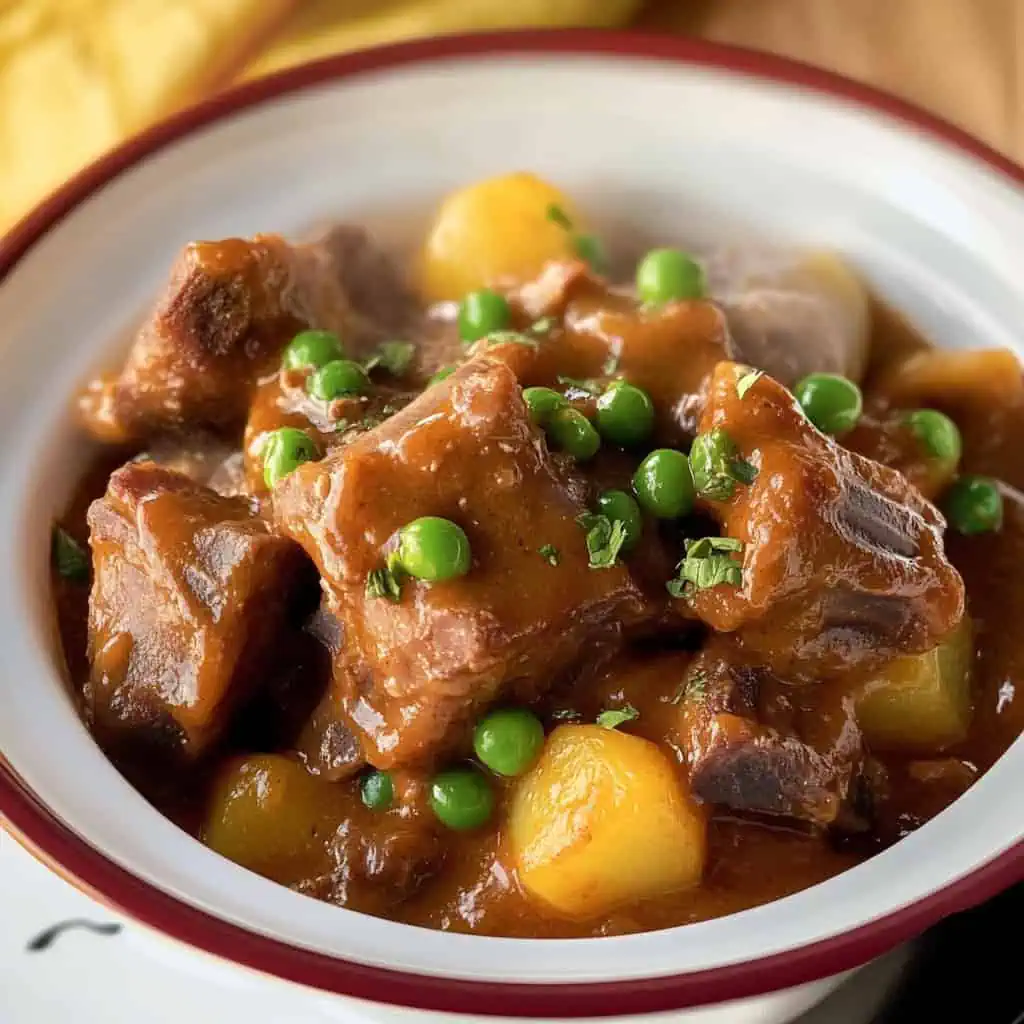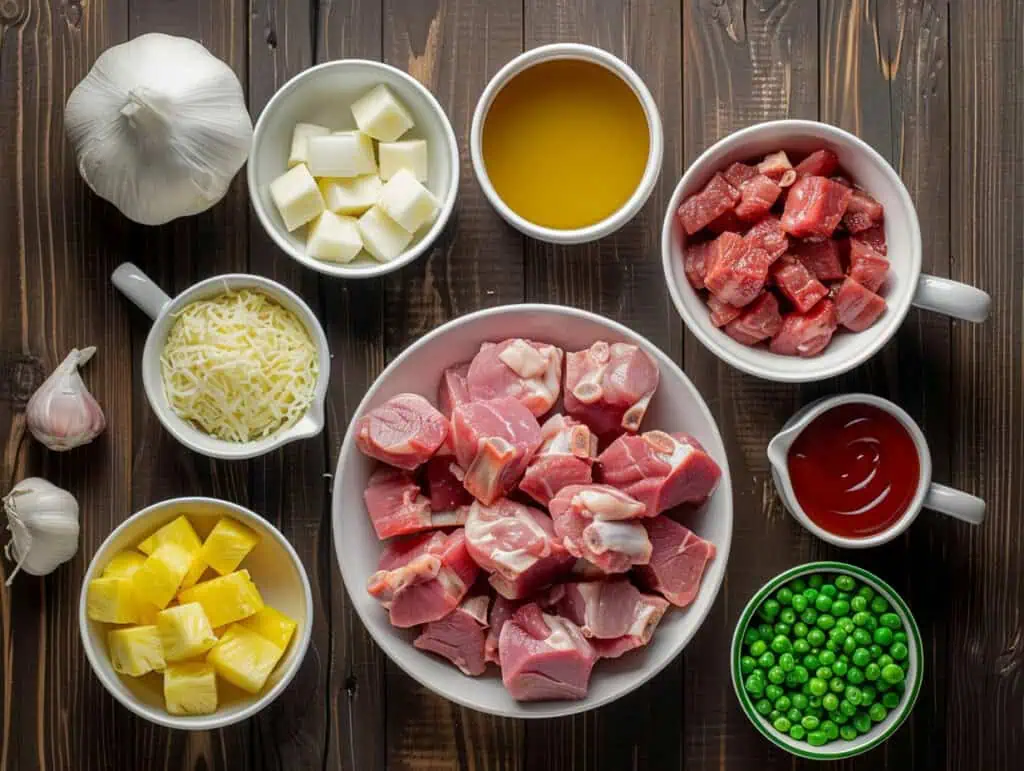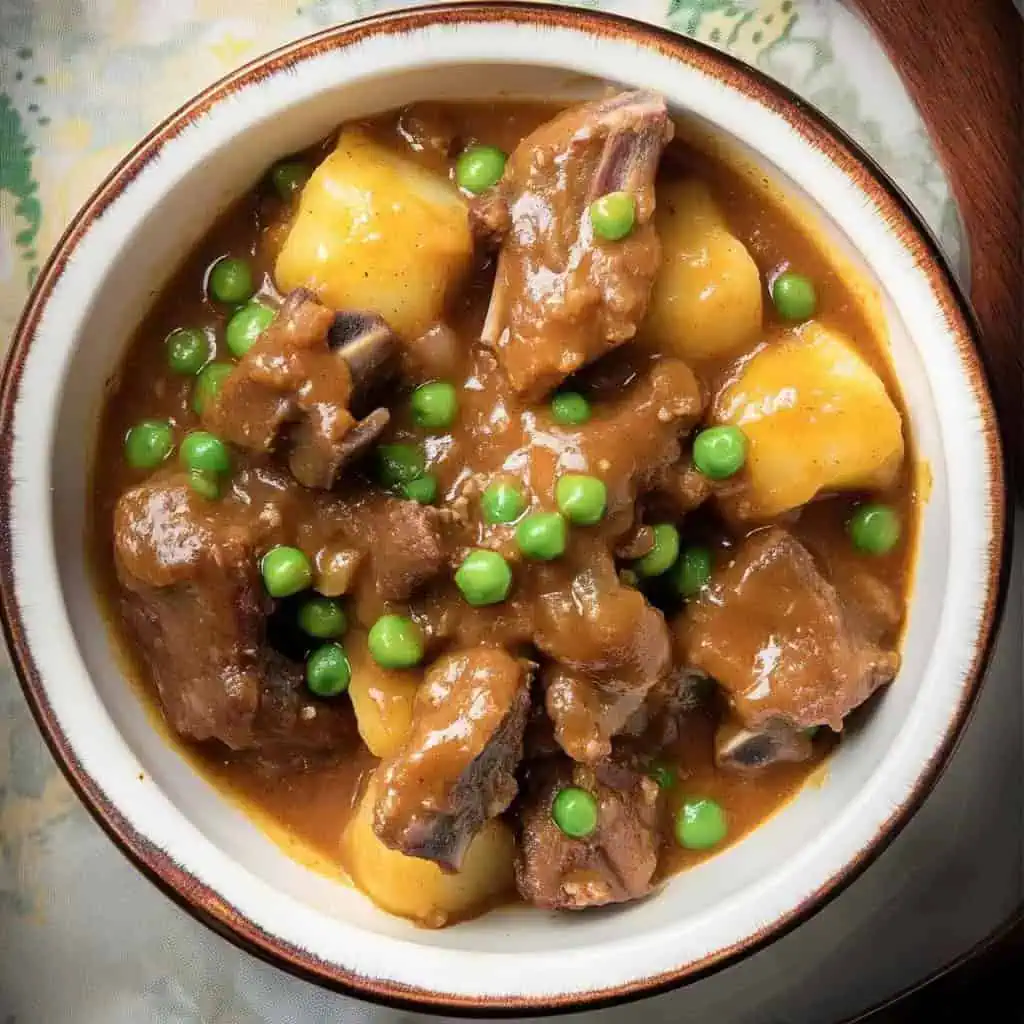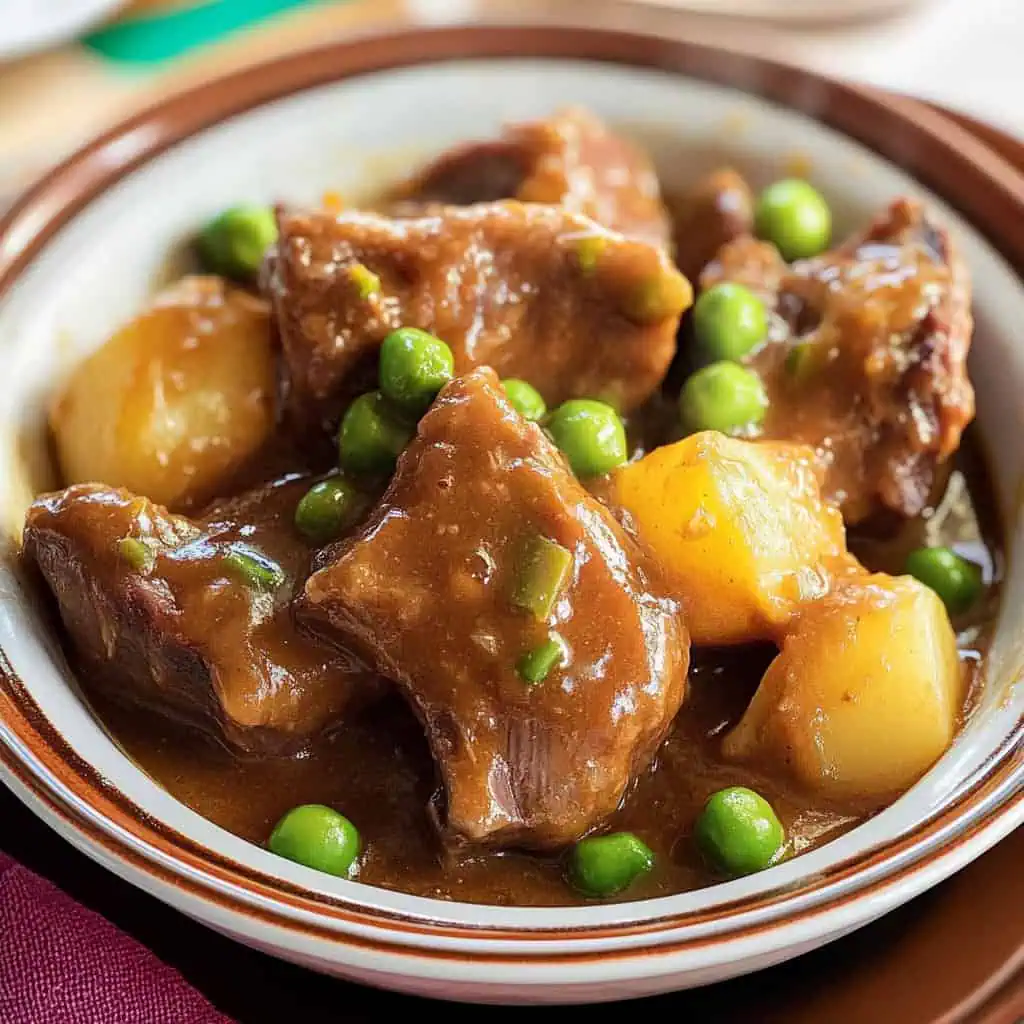Let me introduce you to one of Quezon Province's best-kept secrets, Sinantomas. Think of it as kaldereta's fun, quirky cousin that decided to go in a totally different direction.
Instead of the usual spicy kick, this dish takes juicy pork ribs and bathes them in a sweet-tangy sauce made with pineapple juice and banana ketchup, then gets extra creamy with melted cheese.
I know it might sound a bit unusual, but once you try this unique combo of flavors, you'll wonder where it's been all your life. Perfect for family dinners or when you want to impress your friends with something they've probably never tried before.
Jump to:

Why You'll Love This Recipe
- Unique Flavor Profile: The combination of pineapple juice, soy sauce, and cheese creates an unforgettable sweet-savory taste
- Make-Ahead Friendly: Tastes even better the next day
- Budget-Friendly: Uses simple ingredients available in any Filipino market
- Family-Size Portions: Perfect for family gatherings or parties
- Versatile: Works as both pulutan (appetizer) or ulam (main dish)
Ingredients
Each ingredient in Sinantomas plays a key role in creating its distinctive flavor profile. Pork ribs provide a rich, tender base that absorbs the sweet-tangy marinade beautifully. Pineapple juice not only tenderizes the meat but contributes a tropical sweetness that's quintessentially Filipino.
Banana ketchup adds depth and a hint of spice while maintaining the dish's signature sweetness. The addition of potatoes creates heartiness and helps balance the sauce, while green peas add color and texture contrast. Perhaps most surprisingly, the cheese transforms an already delicious stew into something extraordinary – creating a creamy, velvety sauce that coats each bite with comforting richness.
These seemingly disparate ingredients come together in perfect harmony, exemplifying Quezon Province's creative approach to traditional Filipino cooking.

- 2 pounds pork spare ribs, cut into 1½ inch pieces
- 1 cup pineapple juice
- ½ cup soy sauce
- ¼ cup banana ketchup
- 1 teaspoon salt
- ¼ teaspoon black pepper
- ¼ cup canola oil
- 2 medium potatoes, peeled and quartered
- 1 large onion, peeled and thinly sliced
- 3 cloves garlic, peeled and minced
- 1.5 - 2 cups water
- 1 cup frozen green peas, thawed
- ½ cup shredded processed cheese
Equipment
- Large Marinating Bowl - For thoroughly coating the meat with marinade and ensuring even flavor distribution
- Heavy-bottom pan or Dutch oven - Provides consistent heat distribution and prevents burning the sauce
- Sharp knife - Essential for properly cutting the meat into uniform pieces
- Wooden spoon - Prevents scratching your cookware while stirring and prevents overworking the meat
- Measuring cups and spoons - Ensures recipe accuracy for perfect flavor balance
- Strainer - Used for separating the meat from the marinade
- Kitchen thermometer (optional) - Helps verify meat doneness and food safety

How To Make
- Marinate the pork ribs in pineapple juice, soy sauce, banana ketchup, salt, and pepper for at least 30 minutes (overnight is better). After marinating, remove the meat and save the marinade for later use.
- Heat oil in a large pan over medium-high heat. Fry the potato pieces until they turn light brown, about 5-7 minutes. Remove and set aside.
- Remove most of the oil from the pan, leaving about 1 tablespoon. Cook the onions until translucent, about 3-4 minutes. Add garlic and cook until fragrant, about 1 minute.
- Add the marinated pork to the pan. Cook until it browns on all sides, about 8-10 minutes. Pour in the reserved marinade and water. Bring to a boil, then reduce heat.
- Skim off any foam that forms on top. Cover and simmer on low heat until the meat is tender, about 45-50 minutes. Test by poking with a fork – it should slide through easily.
- Return the fried potatoes to the pan when the meat is tender. Let them cook for 3-4 minutes. Add the green peas and gradually incorporate the cheese while stirring. Continue cooking until the sauce thickens slightly and all the cheese melts, about 5-7 minutes.
- Taste and adjust seasoning if needed. Serve hot with steamed rice.

Tips from Lola's Kitchen
- Choose ribs with good meat-to-fat ratio for the best flavor and juiciness
- Marinate overnight for deeper flavor penetration and more tender meat
- Don't rush the browning process – this crucial step develops rich flavor
- Keep potato pieces large to prevent them from falling apart during cooking
- Add cheese gradually while stirring to create a smooth, clump-free sauce
- Allow the dish to rest for 10 minutes before serving to let flavors meld together
- Reserve a small portion of cheese to sprinkle on top just before serving for visual appeal
Substitutions
- Pork Ribs: Pork belly or shoulder work well as alternatives
- Banana Ketchup: Substitute with tomato sauce mixed with 2 teaspoons brown sugar
- Potatoes: Sweet potatoes provide a delicious twist with added nutritional benefits
- Processed Cheese: Quick-melting cheese, cheddar, or even cream cheese can work
- Pineapple Juice: Fresh pineapple puree or canned pineapple chunks blended with their juice
- Green Peas: Bell peppers or carrots can add color and nutrition if peas aren't available
Troubleshooting
- Tough Meat: Extend cooking time by 15-20 minutes; ensure consistent low simmer
- Sauce Too Thin: Simmer uncovered for 10-15 minutes to reduce; add 1 tablespoon cornstarch slurry if needed
- Sauce Too Thick: Add water gradually, ¼ cup at a time, until desired consistency is reached
- Potatoes Breaking Down: Cut larger pieces, reduce stirring frequency, or add them later in the cooking process
- Cheese Not Melting Properly: Lower heat significantly, remove from heat source if needed, and stir constantly
- Dish Too Sweet: Balance with 1-2 teaspoons vinegar or a squeeze of fresh lemon juice
Storage & Reheating
- Refrigerator: Store in an airtight container for 3-4 days
- Freezer: Keeps well for up to 2 months (best without potatoes as they can become mealy)
- Reheating: Warm over medium-low heat with occasional gentle stirring
- Moisture Control: Add 2-3 tablespoons water if sauce has thickened too much during storage
- Safety: Always reheat to an internal temperature of 165°F (74°C)
- Flavor Enhancement: A sprinkle of fresh cheese when reheating refreshes the dish

FAQ
Why is it called Sinantomas?
The name comes from Quezon Province dialect, though its exact etymology remains debated among culinary historians.
Can I make this ahead for a party?
Absolutely! The flavors actually improve overnight as they meld together. Reheat gently before serving.
Is this dish spicy?
No, Sinantomas is characteristically sweet-savory. Add bird's eye chilies if you prefer some heat.
Can I use other meats besides pork?
Yes, though cooking times will vary. Chicken thighs work well (reduce cooking time to 30 minutes) and beef chuck is excellent (increase cooking time to 90 minutes).
Why add cheese to a Filipino dish?
It's a unique regional addition that demonstrates Filipino culinary creativity. The cheese adds creaminess and depth that perfectly balances the sweet-tangy sauce.
Can I make this dish less sweet?
Reduce the banana ketchup to 2 tablespoons and use unsweetened pineapple juice for a more savory profile.
What makes this different from regular kaldereta?
Traditional kaldereta typically uses tomato sauce and liver spread with a spicy profile, while Sinantomas embraces sweet-tangy flavors with cheese for creaminess.
Is this dish gluten-free?
Not traditionally, due to the soy sauce. Use tamari or coconut aminos for a gluten-free version.
Related
Looking for other recipes like this? Try these:

Quezon-Style Sinantomas (Cheesy Pineapple Pork Ribs)
Equipment
- Large Marinating Bowl (Mangkok na malaki) For marinating the meat evenly
- Heavy-bottom pan or Dutch oven (makapal na kawali) Ensures even heat distribution and prevents burning
- Sharp knife [Matalas na kutsilyo] For cutting meat and vegetables
- Wooden spoon (sandok na kahoy) To prevent scratching your cookware
- Measuring cups and spoons (Panukat) For accurate measurements
- Strainer [Salaan] For draining marinated meat
- Kitchen thermometer (optional) To check meat doneness
Ingredients
For the Marinade
- 2 pounds pork spare ribs Tadyang ng baboy, cut into 1½ inch pieces
- 1 cup pineapple juice Katas ng pinya
- ½ cup soy sauce Toyo
- ¼ cup banana ketchup Banana catsup
- 1 teaspoon salt Asin
- ¼ teaspoon black pepper Paminta
For Cooking
- ¼ cup canola oil Mantika
- 2 medium potatoes Patatas, peeled and quartered
- 1 large onion Sibuyas, peeled and thinly sliced
- 3 cloves garlic Bawang, peeled and minced
- 1.5 - 2 cups water Tubig
- 1 cup frozen green peas Gisantes, thawed
- ½ cup shredded processed cheese Queso
Instructions
- Marinate the pork ribs in pineapple juice, soy sauce, banana ketchup, salt, and pepper for 30 minutes. After marinating, remove the meat and save the marinade for later.
- Heat oil in a large pan over medium-high heat. Fry the potato pieces until they turn light brown, about 5-7 minutes. Take them out and set aside.
- Remove most of the oil from the pan, leaving about 1 tablespoon. Cook the onions until they become clear, about 3-4 minutes. Add garlic and cook until you can smell it, about 1 minute.
- Add the marinated pork to the pan. Cook until it browns on all sides, about 8-10 minutes. Pour in the saved marinade and water. Let it come to a boil, then lower the heat.
- Remove any foam that forms on top. Cover and cook on low heat until the meat is tender, about 45-50 minutes. Check by poking with a fork – it should go through easily.
- When the meat is tender, put the fried potatoes back in. Let them cook for 3-4 minutes. Add the green peas and slowly add the cheese while stirring. Keep cooking until the sauce gets a bit thick and all the cheese melts, about 5-7 minutes.
- Taste and add more salt if needed. Serve hot with steamed rice. You can serve with a small bowl of vinegar on the side if you like.
Tips from Lola's Kitchen
- Choose ribs with good meat-to-fat ratio for best flavor
- Marinate overnight for deeper flavor penetration
- Don't skip browning the meat - it develops better flavor
- Keep potatoes large so they don't disintegrate
- Add cheese gradually while stirring to prevent clumping
Nutrition
The Story Behind Sinantomas
In the sun-drenched province of Quezon, where coconut trees sway and local cuisine tells stories of innovation, Sinantomas emerged as a delightful testament to Filipino culinary creativity. This unique dish, a regional interpretation of the more widely known kaldereta, showcases how local cooks transformed a classic recipe into something entirely their own.
While kaldereta traces its roots to Spanish colonization, with its name derived from "caldereta" meaning cauldron, Sinantomas represents Quezon Province's distinctive approach to reinventing traditional fare. Local legend suggests that the dish was born in the bustling kitchens of Lucban, where resourceful home cooks experimented with readily available ingredients. The addition of pineapple juice – perhaps influenced by the province's abundant fruit harvests – and the unexpected incorporation of cheese speaks to the Filipino talent for combining seemingly disparate flavors into harmonious dishes.
What makes Sinantomas particularly fascinating is its deviation from kaldereta's characteristic heat. Instead of leaning into spicy notes, this Quezon variation embraces a sweet-savory profile that perfectly captures the region's palate. The use of banana ketchup, a distinctly Filipino condiment born from the resourcefulness of war-time cooking, adds another layer of cultural significance to the dish. This ingredient choice wasn't just about flavor – it represents the innovative spirit of Filipino cooking, where making do with available ingredients often results in spectacular culinary discoveries.
Today, Sinantomas stands as more than just a recipe; it's a reflection of Quezon's culinary heritage. Found at family gatherings, fiestas, and local carinderia (small eateries), the dish continues to evolve while maintaining its core identity. Some families pass down closely guarded variations, adding their own twists while preserving the essential combination of pork, pineapple, and cheese that makes Sinantomas instantly recognizable to those familiar with Quezon's local cuisine.
As Filipino food gains global recognition, regional specialties like Sinantomas remind us that Philippine cuisine is far from monolithic. Each region, each province, and often each town contributes its own chapter to the country's rich culinary narrative. In Quezon's case, Sinantomas stands as a delicious reminder of how local ingenuity and traditional cooking techniques can come together to create something uniquely Filipino.










Comments
No Comments